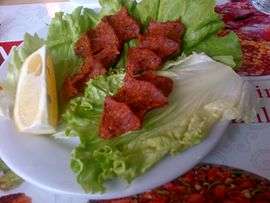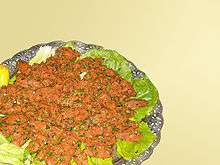Çiğ köfte
Çiğ köfte (Turkish pronunciation: [tʃiː cœfte]) or chee kofta[1] is a raw meatball dish in Armenian, Kurdish and Turkish cuisines and very similar to kibbeh nayyeh and to a lesser extent to steak tartare. It is traditionally made with either beef or lamb, but in Turkish restaurants and fast food spots only the vegetarian variety made with extra fine bulgur may be served. Ciğ köfte may be served as an appetizer or meze.
 Çiğ köfte meal in Turkey | |
| Main ingredients | Bulgur, onion, tomato paste, hot red pepper paste, urfa biber, salt |
|---|---|
| Ingredients generally used | Fresh mint, parsley, spice, lemon, olive oil |
Meat differences
In the beef variant, ground beef is used. Tendons and fat are removed before grinding the beef. High-quality beef is required, since it is served raw.[1]
Since lamb is considered a "clean meat", it is often used for çiğ köfte instead of beef. Both Armenians and Turks use çiğ köfte as a meze, served almost cold. The raw meatball, or kofta, is not kept overnight and is reserved for special occasions. The lamb used must be deboned and trimmed of gristle and fat before it is prepared. The lamb is supposed to be butchered, bought, and prepared the very same day to ensure freshness.
With either meat, finely ground bulgur (durum and other wheat) is required. Other ingredients are mild onions, scallions, parsley, and usually green pepper. Variants of the dish may use tomato sauce, Tabasco sauce, and mint leaves. When served, it may be gathered into balls, or in one piece. Crackers or pita bread are sometimes used to consume it.[2]
Armenia
Chi Kofte is considered a delicacy in Cilician Armenian culture and is normally prepared on special occasions, especially during holidays. There are many varieties of chi kofte among Armenian families depending on the historic region they are from and their personal preferences. For example, some may use more or less bulgur, and some may use more or less pepper paste depending on their desired spiciness.
Traditional Armenian chi kofte is made in two varieties, either in loose meatball form in the shape of a small egg, or flattened on a plate with olive oil and minced green onions, similar to kibbeh nayyeh. However, unlike Levantine Arabs, eating chi kofte with bread is not common among Armenians.
A vegetarian variety also exists which is shaped very similarly to chi kofte and with a similar texture. Although it is prepared throughout the year, it is particularly popular during Lent in accordance with the diet restrictions of the Armenian Apostolic Church.
Chi kofte was introduced in the United States by Armenian immigrants, and was commonly referred to as Armenian steak tartare. This term is not as common today based on the declining popularity of steak tartare.
Turkey

In Turkish, çiğ means "raw" and köfte means meatball. The word köfte derives from Persian, ultimately from the Proto-Indo-European root "*(s)kop–" (grind, pound, beaten).[3] It is found in Kurdish and Persian languages as "kōfta (كوفته)" or "kûfte". It is a favorite Kurdish & Turkish snack and a specialty of Kurdish majority southeastern Turkey, especially Şanlıurfa[4], Diyarbakir[5] and Adıyaman.
Bulgur is kneaded with chopped onions and water until it gets soft. Then tomato and pepper paste, spices and very fine ground beef or lamb are added. This absolutely fatless raw mincemeat is treated with spices while kneading the mixture, which is said to "cook" the meat.[6] Lastly, green onions, fresh mint and parsley are mixed in. Some çiğ köfte makers, particularly in Adıyaman, do not use water in their recipes. Instead of water, they use ice cubes and lemons. One spice that is associated with çiğ köfte, and with Şanlıurfa as a whole, is isot, a very dark, almost blackish paprika, prepared in a special manner, and which is considered as indispensable for an authentically local preparation of çiğ köfte.
A vegetarian version of ciğ köfte may also be made with only bulgur grains. The preparation is similar to the versions that include meat and some cooks also add pomegranate molasses. Depending on the cooks preferences, spices like cumin may be used instead of isot in the preparation of vegetarian versions.[7]
A favorite way of eating çiğ köfte is rolled in a lettuce leaf, accompanied with good quantities of ayran to counter-act the burning sensation that this very spicy food will give.
Although traditional recipe requires minced -raw- meat, the version in Turkey consumed as fast-food (through small franchise shops in every neighborhood of Turkey) must be meatless by law due to hygienic necessities.[8] Therefore, çiğ köfte is, unless specifically made, vegan in Turkey. Meat is replaced by ground walnuts, hazelnuts and potato.[9][10][11] Both meaty and meatless çiğköfte varieties are intended to be consumed in the same day it was produced.
References
- Perry, Charles (12 March 1992). "The Hollywood Walk of Food". Los Angeles Times. p. 12. Retrieved 2019-09-22.
- Wise, Victoria. The Armenian Table (Macmillan, 2004, ISBN 0-312-32531-2) p.104
- Nişanyan, Sevan. "kofte". Nişanyan Sözlük. Retrieved 2020-02-25.
- "Friends of Anatolia - Friendly News Issue 3". Retrieved 3 January 2016.
- Kitchen, Leanne. Turkey: More Than 100 Recipes, with Tales from the Road. Chronicle Books, 2012. ISBN 9781452107707.
- Planet, Lonely (2014-02-01). The World's Best Spicy Food: Where to Find it & How to Make it. Lonely Planet. ISBN 978-1-74360-421-2.
- "Nar Ekşili Antep Çiğ Köfte". Nurselin Mutfağı. Retrieved 2018-11-08.
- "Etli çiğ köfte masum mu?". Retrieved 3 January 2016.
- "Etsiz çiğ köfte çağındayız". Kocaeli Gazetesi. 19 August 2015. Retrieved 3 January 2016.
- TE Bilisim - Abdullah Tekin. "Çiğ köftenin 10 faydası". Retrieved 3 January 2016.
- TE Bilisim - Abdullah Tekin. "Üniversiteli çiğköfteciler!". Retrieved 3 January 2016.